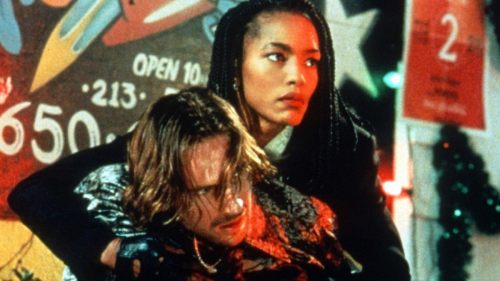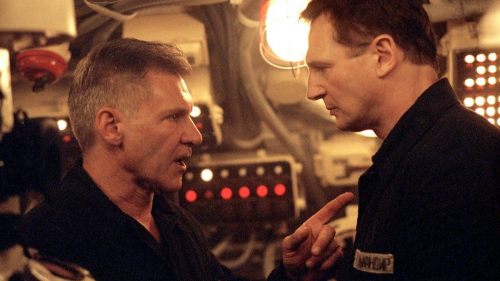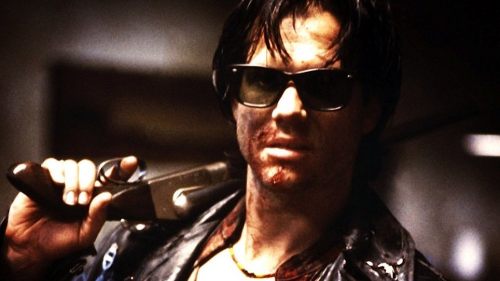Broad Cinema: The Films of Kathryn Bigelow
From Alice Guy-Blaché to Ava Duvernay, women have been integral to cinema for the last 120 years. Broad Cinema is a new column that will feature women who worked on films that are playing this month at the Alamo Drafthouse. From movie stars to directors, from cinematographers to key grips, Broad Cinema will shine a spotlight on women in every level of motion picture production throughout history.
This week we are celebrating Kathryn Bigelow, whose Detroit is out right now. Get your tickets here.
When we rank the most well-known directors of our time, the honor always goes to the men who have managed to take their auteur vision and apply it to crowd-pleasing films: Spielberg, Scott, Tarantino, Nolan, Scorsese, Cameron. They have achieved the high wire balance of maintaining their own flavor while keeping studios placated. Then you have the auteur darlings, the ones loved by critics: Fincher, Allen, Herzog, Anderson. There are the ones who have since passed, but continue to be regarded as influential luminaries: Hitchcock, Kurosawa, Kubrick, Lumet, Ford, Fellini, Lang.
Kathryn Bigelow is a director who rarely makes it on anyone’s most influential director list — few female directors ever do. The truth is, it’s hard to know how to categorize Bigelow, and we tend to like things that can be defined, named and placed. But Bigelow has never particularly been interested in fitting into a neat box or achieving accolades; the balletic grace of violence, social commentary, putting her characters in pressure-filled scenarios, these are the rewards that Bigelow has chased.
This week, Kathryn Bigelow’s Detroit hits theater screens. Brutal, unflinching, shining an uncomfortable light on the racial realities of the United States, Detroit is not an easy film. The tenth feature-length film of her career (nine if you don’t count The Loveless, the student film she shot with Monty Montgomery), in many ways it feels as though every Bigelow film before has simply been prep for this. The themes present in Detroit are all elements that Bigelow has been fine-tuning for the last three and a half decades.
NEAR DARK (1987)
On its surface, Near Dark is a bloody vampire flick with a trio of actors borrowed from the previous year’s Aliens: Bill Paxton, Lance Henriksen, and Jenette Goldstein, and an almost shockingly young Adrian Pasdar in the lead role of Caleb Colton—the film is a shining example of “Hey, I know that guy!” Its premise—a farmboy from the Midwest accidentally gets bitten and turned when he falls in love with a beautiful and mysterious vampire—seemed to be tailored for the explosion of high concept blockbuster movies that proliferated the ‘80s.
But there is much more at work than a straightforward horror flick. It was our first taste of Bigelow’s genre-mashing and subverting style, as much a romance as a vampire flick, as much a moody road trip movie as it is full of savage violence. When young Caleb gets pulled into the orbit of the drifter vampire gang, he is increasingly submerged in a brutal and violent world. There is no post-Anne Rice Gothic ennui and pull to the dark side here, no noble vampires who eschew violence and preying on humans; the bloodsuckers of Bigelow’s world are depraved, reveling in violence and murder.
Just as the vampires are unexpected, so is Caleb. The arc we would expect is that he succumbs to his vampirism and learns to embrace his bestial nature in the name of love. But Caleb fights losing his humanity every step of the way and puts that above everything, even staying with Mae. It’s a surprising subversion, but one that speaks to Bigelow’s fascination with the entirety of human nature, not just one aspect of it. Though she most often explores the darker passions and uglier tendencies of humanity, there are numerous moments in her films of characters rising to the better angels of their nature, however fleeting.
BLUE STEEL (1990)
Most people jump right to Point Break when they think of Bigelow’s earliest works, but a career retrospective would be remiss without including Blue Steel. Released three years after Near Dark and one year before Point Break, Blue Steel was, like many of Bigelow’s earlier films, diminished by oversimplification, initially regarded as a simple cat and mouse thriller. Jamie Lee Curtis plays Megan Turner, a rookie cop who becomes the object of a psychopath’s obsession after a chance encounter during an unrelated grocery store robbery.
It’s edgy and nervy and twisted, and it dives into the deep end of one of the most enduring themes in Kathryn Bigelow’s filmography. As a woman dismissed by her peers and struggling to be heard and taken seriously in a male-dominated profession, at one point in Blue Steel, Turner is raped by her stalker. In Bigelow’s films, women are not treated well. They are dismissed and undervalued at best by the men around them, brutalized at worst.
As a director who has always been unflinching in showing an audience the ugly reality of the world, Bigelow is simply reflecting how women are treated. Blue Steel has prescience of message that seems particularly relevant with today’s growing awareness of rape culture, but the themes of the diminished value of women in the eyes of men and the dismissive blindness of authority have been weaving themselves through Bigelow’s work since the early days.
POINT BREAK (1991)
With Point Break, Bigelow finally found the marriage of success both commercial and cult. There are those of us who will likely always remember Patrick Swayze as a golden-haired surf god, who will never be able to look at masks of presidents without immediately associating them with bank robberies, who grew up with the Zen (okay…Zenish) philosophy of Swayze’s Bodhi (“It ain’t tragic to die doing what you love.”) and trying to emulate the youthful swagger of Keanu Reeves’ Johnny Utah.
But with Bigelow in the director’s chair, a movie that should have been a simple action flick became something over-the-top (skydiving surfers—skydiving surfers!), a send up of the testosterone-driven bromances of the action genre. Bodhi and Johnny Utah’s friendship borders on the homoerotic and action becomes spectacle, a near-parody of the genre that revels in its self-aware embrace of the unrealistic manly ideal. If Blue Steel was about how men view women, Point Break was about how men want to view themselves. It works so well because it never descends into meanness. Neither Reeves nor Swayze take themselves too seriously, but Bigelow’s genuine love of action and adrenaline shines through. It’s as much homage as it is parody; all the best genre-subverting films are.
STRANGE DAYS (1995)
On paper, Strange Days, directed by a post-Point Break Bigelow and with a script by her former husband, James Cameron, should have been a hit. Instead, the sci-fi noir thriller was a flop that almost permanently derailed Bigelow’s career. Like many cult sci-fi films of the era, it dealt with the dark side of technology and corruption of authority; unlike those films, it went to places too dark for broad audiences to embrace.
In Los Angeles on the eve of a new millennium, Bigelow paints a dystopian picture that revolves around Ralph Fiennes’ Lenny Nero, a former cop turned black market SQUID disc dealer, an illegal technology that wires directly into your brain and then records your memories—including sensations and emotions—onto discs for playback at any time. In turn of the century LA, there are drugs, but the most coveted and dangerous drug of all is to exist as someone else for a while. Bigelow’s Los Angeles isn’t an easy or happy one, less glitzy Beverly Hills 90210 and more seedy LA Confidential noir underbelly. The pressure cooker feeling is enhanced by the fact that Bigelow herself was deeply influenced by the Rodney King riots. With a subplot that involved the murder by police of a black rapper turned activist, Bigelow sought to bring the “palpable sense of anger and frustration” to the film she felt in the streets in a post-Rodney King trial LA.
THE WEIGHT OF WATER (2000)
The Weight of Water is often the overlooked cinematic child of Bigelow’s brood, not without reason. Like all of Bigelow’s work, it enjoys a stellar cast, this one carried by the strength of its women. Jean Janes (Catherine McCormack) travels to an island off the coast of New Hampshire to research the 1873 murder of two women for an editorial, based on the testimony of a third survivor, Maren (Sarah Polley). Her husband, Thomas (Sean Penn), accompanies her, along with his brother, Rich (Josh Lucas), and Rich’s girlfriend, Adaline, played by Elizabeth Hurley. As Jean investigates the murders, her own marriage starts to fray with jealousy as she becomes convinced that Thomas is having an affair with the gorgeous Adaline.
It’s possibly the most personal of Bigelow’s films, and certainly ambitious, but to say it’s messy would be generous. Nonlinear storytelling is always tricky, but added to the unconventional narrative is that fact that it’s also told in multiple time frames and periods—there are flashbacks within flashbacks—and from two different perspectives, with Jean narrating the events in modern time and Maren the events of the 1870s. Still, I have to appreciate Bigelow swinging for the fences; The Weight of Water takes a gutsy, no-fucks-given approach even for a director who has never particularly cared about sticking to the established norm in the first place.
But it’s a film worth watching if only for Bigelow’s masterful way with ratcheting up psychological tension. It’s an absolutely feminist film in that it explores psychological deterioration from a uniquely feminine point of view. Sexual jealousies abound and the fear of no longer being sexually attractive; a fear also shared by men, but for women, upon whom physical beauty has always been placed at a higher premium, it’s particularly deeply-rooted. The repression of rage and jealousy plays a part, as well. Women are not meant for rage, they are simply meant to endure. For Bigelow, who puts more of herself into her films than most directors working today, it’s as much a statement on how she feels about the idea of feminine repression as a fictional narrative.
K-19: THE WIDOWMAKER (2002)
K-19 is worth including in any retrospective about Bigelow in 2017, if only because it’s the film that helped the director cut her teeth on military settings. Based on a true story, it tells the tale of a nuclear Russian submarine that experiences a catastrophic failure during a run as its crew scrambles to get it operational again and prevent a nuclear meltdown. I’d like to think that it helped pave the way for The Hurt Locker and Zero Dark Thirty, if only because it planted the seeds of thoughts about power and control in the military, about the psychological pressures that come along with a job in which one must balance increased personal danger with the duty to protect and defend others.
THE HURT LOCKER (2008)
If K-19: The Widowmaker was the movie that temporarily removed Kathryn Bigelow from the Hollywood chess board, The Hurt Locker was the film that dropped her right back into the center of it, winning six Oscars, including Best Picture and Best Director for Bigelow—the first for a woman.
The Hurt Locker also pulled an astonishing performance from Jeremy Renner in the role of Staff Sergeant William James, newly assigned to oversee an elite bomb disposal team during the Iraq War. But there are more than a few loose threads in James’ head, and his unconventional ways of running the team become increasingly erratic and dangerous. Bigelow’s deft way of showing how a character reacts when placed in a pressure cooker situation is inverted here where James is concerned; the problem with the team leader isn’t that he can’t handle high pressure situations, it’s that he doesn’t know how to survive without them. He feeds on it, needs it to the point that he puts himself and his team in danger simply to feel alive and have purpose. The moment before disarming an IED that could explode and kill him is the high he lives for; doing the most dangerous and unpredictable job in the military is the only thing he loves.
This is the psychological secret that Bigelow exposes in The Hurt Locker, the fundamental truth no one wants to talk about: There is a certain type of man who thrives on war, on battle, on the possibility of death, living a thin life on the knife edge of mortality. They are military lifers not for the benefits or the security or the drive to protect and serve, but because it is the only occupation in which they can channel their darker and self-destructive urges and have them be labeled heroic; the same could be said of the police force. There are echoes of James in Will Poulter’s sadistic, trigger-happy Krauss in Detroit; it’s who James might have been had his extremism been externally focused instead of internal.
ZERO DARK THIRTY (2012)
Zero Dark Thirty is masterful. There’s really no other way to describe it. As a lengthy procedural that retells the hunt for Osama bin Laden, it’s less complicated and daring in structure than some of Bigelow’s other work, yet the lean and simple storytelling allows the best of her talents to be distilled down to their essence, as well as allows Jessica Chastain to shine in the role of Maya, the CIA analyst who finally tracks Bin Laden down.
Bigelow has always been particularly good at injecting much of herself into a film without making any particular moral judgments. There is always fiction in fiction, but Bigelow rarely shows what she feels the world should or shouldn’t be, simply what it is. In an era in which it is demanded of artists and creators to make their own left-leaning morals clear in their work, it was a skill that got her mired in controversy after Zero Dark Thirty depicted the torture and enhanced interrogation tactics used on detainees. It’s a skill that should be applauded. Bigelow’s indifference to trying to impress or cater to anything outside of the story being told is increasingly rare in a time where mob mentality continually forces creators to compromise.
Perhaps that’s Kathryn Bigelow’s greatest gift as a director: She doesn’t compromise, not for herself and not for her audience. She won’t spoon feed you an interpretation; while there is good and bad in her films, the vast majority of her characters exist on the gray moral spectrum. It’s up to us as the audience to decide for ourselves how we feel about it. It’s not that it’s wrong for a director to lead an audience, to tell them how to feel, it’s simply that Bigelow is uninterested in it. Expecting her audience to do the mental and emotional work for themselves has always been part of Bigelow’s cinematographic DNA.



